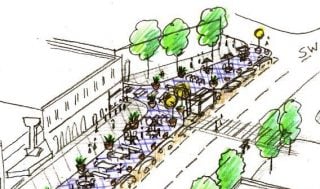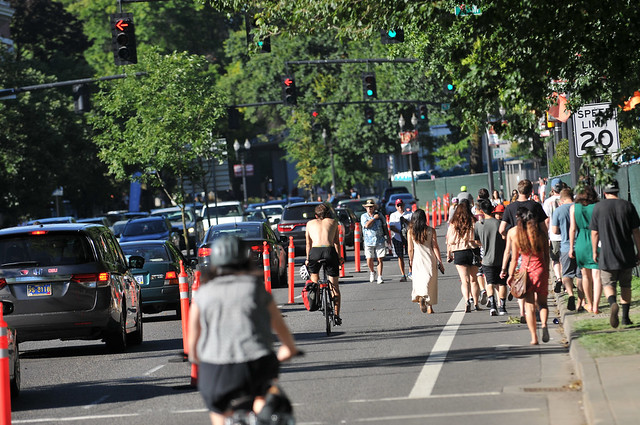
The City of Portland’s transportation bureau got past a key milestone on Wednesday when City Council voted to move forward with their Livable Streets Strategy.
Specifically, council supported the city’s $149,158 contract with consulting firm Nelson/Nygaard to come up with the framework of the strategy and set into motion what we’ve called “a new era of open streets.”
But during Wednesday’s otherwise uneventful council session we got a unexpected preview of the political debate that might lie ahead.
PBOT’s Livable Streets Strategy is an umbrella for several different new initiatives. It’s all about formalizing the inevitable (and long overdue) march toward Portland squeezing more potential out of its public right-of-way. Our streets are mostly dominated by cars — both in city policy and in daily reality. As Portland grows and non-car travel options become more popular and more necessary, we must transition away from the traditional, 1970s auto-centric planning paradigms. PBOT has already started this update process by reconfiguring roads to give more space to people to walk, bike and take transit and less space for private auto use.
But we have a very long way to go. And this work has taken on even more urgency with the launch of Biketown, our new bicycle transit system that already has over 7,000 riders.
Here’s a snip from the ordinance (PDF):
“Livable Streets Strategy will support innovation in the public right-of-way by opening Portland’s streets, parking spaces, plazas, and alleys to a range of events, programming, and physical infrastructure that reinforce the idea that public streets are public places to be enjoyed by all ages and abilities.”
A big part of the strategy will be to empower residents and business owners to propose and implement their own placemaking projects via community grants given out by the city.
After PBOT staff made a brief presentation about the program on Wednesday, Commissioner Nick Fish spoke up. He explained that he sees street management plans as fitting into two distinct camps: “streets and parking spaces,” and “plazas and alleys.” He’s worried about the “consequences” of the former and seems generally supportive of the latter.
Here are his comments in his own words (emphases mine), transcribed from the council meeting (you can also watch his comments in the video clip above):
“My sense is that the issues raised by livable streets as they apply to streets and parking spaces are different than the kind of issues that come up with plazas and alleys. In my own experience working with Commissioner Novick for example on the improvements along Division is that there’s a delicate balance between promoting the laudable goals of this program and also ensuring, for example, that business districts function.
We heard [in the Division conversation], for example, comments like ‘We’re really delighted to have these bioswales, but why did they have to be so big and take up two parking spaces? And why are they in a particular location and on and on.’
Advertisement
I just, as a commissioner, want to make sure that as we deal with the delicate issues of streets and parking spaces — which is a big flashpoint, and frankly, it’s increasingly difficult to get from point a to point b on our streets — that we use a broader lens than livable streets to make those decisions. And I have a different personal standard that I apply to alleys and plazas, because in some cases you’re activating orphan spaces.
The challenge with streets and parking places is we have competing demands. And I just want to put that on the record, a concern that we look at them differently. And frankly, while I now live in a rental apartment and walk to work and have ditched the car, when I am in a car and trying to get from point a to point b, there are huge consequences when we take a lane out of Naito or we close a street. And effectively what it means is that you just can’t get from here to there.
In my job there are times I have to travel by car. It’s just a necessity. So I want to just plant this flag that I’m going to have a different approach to this vis-a-vis streets and parking spaces, and want to know about the tradeoffs, then I would around plazas and alleys where I think there are some really big opportunities to create meaningful public places out of areas that are orphaned, or don’t serve a compelling transportation need. I want to put that on the record.”
By saying he wants to “put this on the record” and “plant this flag,” Fish is laying the rhetorical groundwork for future conversations and telegraphing to PBOT Commissioner Steve Novick and Mayor Charlie Hales that they’ll have to work hard for his vote.
“… I am committed to reducing congestion and unnecessary car idling.”
— Nick Fish, city commissioner
Fish’s comments also express clear concerns about Better Naito, PBOT’s partnership with Better Block to temporarily reconfigure the lanes on Naito Parkway. A successful three-month pilot project ends Sunday and Mayor Charlie Hales plans to ask Fish and the rest of council to use city money (an estimated $1.5 million) to make it permanent in the coming months.
Also notable in his comments: Fish appears fully supportive of new public plazas and innovative uses of our right-of-way, as long the spaces don’t impinge “compelling transportation needs.”
I followed up with the Commissioner after the meeting. When I asked what exactly he meant by “huge consequences” of Better Naito he said (via email), “What I have heard from my constituents is that it is important to balance the needs of all transportation modes. Improving circulation and safety, and expanding bike infrastructure, are not mutually exclusive goals.” And Fish, saying his opinion was informed by the city’s Climate Action Plan, wrote that, “I am committed to reducing congestion and unnecessary car idling.”
It’s worth noting that Fish is the City Council liaison to Venture Portland, an organization that represents our 50 neighborhood business districts. As such, he wants to make sure business owners are at the table when PBOT considers making changes to the right-of-way (PBOT staff said they will be). Fish told PBOT staff that Portland’s neighborhood business owners are, “always struggling with that balance between getting customers in and out of the district and also wanting it to be a safe and welcoming place.”
When I asked what he meant by “ensuring that business districts function,” he said that he hears concerns from neighborhood business leaders about, “the cumulative impact of our decisions.”
“There is a cumulative impact of green street facilities, ROW temporary structures, parking removal and transportation mode additions,” he continued. “We want our business districts to be successful, and that means taking a holistic approach.”
As for whether or not he’d support Better Naito if/when it comes to council in October, Fish said he’s looking forward to a briefing on traffic analysis and results of the pilot project and that he’d, “Keep an open mind.”
— Jonathan Maus, (503) 706-8804 – jonathan@bikeportland.org
Our work is supported by subscribers. Please become one today.



